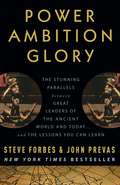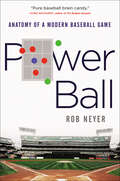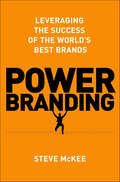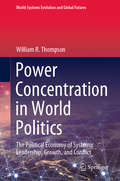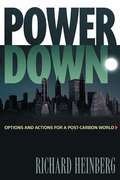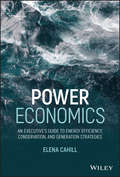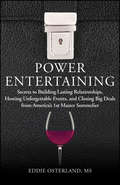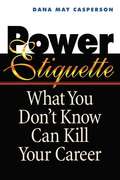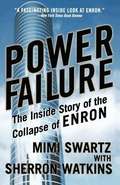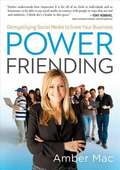- Table View
- List View
Poverty, Progress and Development (Routledge Library Editions: Development)
by Paul-Marc HenryThe studies of poverty, progress and development in this volume, first published in 1991, by a distinguished international roster of authors and researchers, aim to increase knowledge of the social mechanisms of pauperization, marginalization, and the exclusion of certain categories of society; to bring to light the potential and creative role of socio-cultural, intellectual, ethical, moral and spiritual values in progress and the development process; and to examine the links and contradictions between development and progress in order to propose ways of reducing social inequalities.
Poverty, Social Exclusion and Stochastic Dominance (Themes in Economics)
by Satya R. ChakravartyThis book honors the memory of Tony Atkinson, who made significant contributions to the rigorous study of income inequality, poverty, and redistribution. These essays presented, covering a span of over 30 years of research and scholarship, have been at the forefront of distributional analysis, and many of them are of prime importance for contemporary developments in the real-valued measurement of poverty and inequality, with particular reference to the concepts of fuzzy poverty assessment, vulnerability, heterogeneity/multidimensionality, unit consistency, sub-group decomposability, and dominance criteria. While all of these articles have been previously published—singly or with co-authorship—in a number of professional journals or distinguished edited volumes, this book is greatly enriched by a substantial introductions by the authors, which place the contributions in context, highlights their inter-connectedness, and relates them to the work of Tony Atkinson and other scholars. This book is of intrinsic value to welfare analysts, as well as being a tribute to a very great scholar by a fellow economist.
Pow! Right Between the Eyes
by Andy NulmanPow! Radical new methods for reaching jaded, cynical consumersPut simply, when it comes to your business, your new idea, even yourself, this book can be the difference between a "Who cares?" and a "Holy cow!"Business, both big and small, is in desperate need of new ways to inspire bored and cynical consumers who have grown weary of the same old song and dance. In today's information economy, it doesn't matter how many people you reach, but how much attention they pay. And the best way to get attention is with the powerful, but largely misunderstood, element of surprise.Pow! Enter Andy Nulman with the art of surprise marketing. An explosive new outlook, surprise marketing solidifies the bond between you and your customers like nothing else, and keeps them coming back for more by providing a continuous flow of what they never expected. Pow! Right Between the Eyes reveals the secrets, theories, and tactics of surprise marketing, and wields outrageous real-world examples (and even more outrageous tools like "The Lubricant to Yes" and "Euphoric Shock") to help expand the boundaries of the extreme and create a bigger bang for bigger profits.On his quest to unlock the secret of why some things knock your socks off and others put you to sleep, Nulman shares insights from director Alfred Hitchcock, designer Philippe Starck, playwright David Mamet, Family Guy creator Seth McFarlane, Harvard psychologists, songwriters, bloggers, and even the inventor of Pirate Booty snack chips. And he shows how today's smartest companies are winning big with surprises stories like:* How Oprah's shocking announcement that "Everybody gets a car!" sent her Web site traffic up 800% and helped the Pontiac G6 outsell its competitors by 20%* How Target earns $7 billion a year in free publicity with stunts like a floating temporary store in New York's Hudson River or putting on a vertical fashion show where acrobat models walked down the side of Rockefeller Center* How Bear Naked Granola reversed the trick-or-treat tradition by sending costumed street teams door-to-door to give away granola samples on HalloweenAndy Nulman is a wildly-successful businessman and even wilder public speaker who first learned the power of surprise working with Jay Leno, Jerry Seinfeld, Jim Carrey, and many other comedians as the cofounder and CEO of the Just For Laughs Festival, the world's largest comedy event. His book shares hilarious and effective surprise promotions that he himself dreamed up for the event and in his current position as cofounder, President, and CMO of Airborne Mobile, which brings brands like Maxim, Family Guy, and the NFL to the mobile media world.Don't forget to read the book's two forewords by the legendary John Cleese and CBS Late Late Show host Craig Ferguson. Surprising choices for a business book? Well...what did you expect?
Pow! Right in the Eye!: Thirty Years behind the Scenes of Modern French Painting (Abakanowicz Arts and Culture Collection)
by Berthe WeillMemoir of a provocative Parisian art dealer at the heart of the 20th-century art world, available in English for the first time. Berthe Weill, a formidable Parisian dealer, was born into a Jewish family of very modest means. One of the first female gallerists in the business, she first opened the Galerie B. Weill in the heart of Paris’s art gallery district in 1901, holding innumerable exhibitions over nearly forty years. Written out of art history for decades, Weill has only recently regained the recognition she deserves. Under five feet tall and bespectacled, Weill was beloved by the artists she supported, and she rejected the exploitative business practices common among art dealers. Despite being a self-proclaimed “terrible businesswoman,” Weill kept her gallery open for four decades, defying the rising tide of antisemitism before Germany’s occupation of France. By the time of her death in 1951, Weill had promoted more than three hundred artists—including Henri Matisse, Pablo Picasso, Amedeo Modigliani, Diego Rivera, and Suzanne Valadon—many of whom were women and nearly all young and unknown when she first exhibited them. Pow! Right in the Eye! makes Weill’s provocative 1933 memoir finally available to English readers, offering rare insights into the Parisian avant-garde and a lively inside account of the development of the modern art market.
Pow! Right in the Eye!: Thirty Years behind the Scenes of Modern French Painting (Abakanowicz Arts and Culture Collection)
by Berthe WeillMemoir of a provocative Parisian art dealer at the heart of the 20th-century art world, available in English for the first time. Berthe Weill, a formidable Parisian dealer, was born into a Jewish family of very modest means. One of the first female gallerists in the business, she first opened the Galerie B. Weill in the heart of Paris’s art gallery district in 1901, holding innumerable exhibitions over nearly forty years. Written out of art history for decades, Weill has only recently regained the recognition she deserves. Under five feet tall and bespectacled, Weill was beloved by the artists she supported, and she rejected the exploitative business practices common among art dealers. Despite being a self-proclaimed “terrible businesswoman,” Weill kept her gallery open for four decades, defying the rising tide of antisemitism before Germany’s occupation of France. By the time of her death in 1951, Weill had promoted more than three hundred artists—including Henri Matisse, Pablo Picasso, Amedeo Modigliani, Diego Rivera, and Suzanne Valadon—many of whom were women and nearly all young and unknown when she first exhibited them. Pow! Right in the Eye! makes Weill’s provocative 1933 memoir finally available to English readers, offering rare insights into the Parisian avant-garde and a lively inside account of the development of the modern art market.
Power Ambition Glory: The Stunning Parallels Between Great Leaders of the Ancient World and Today... and the Lessons You Can Learn
by Steve Forbes John PrevasBased on an extraordinary collaboration between Steve Forbes, chairman, CEO, and editor in chief of Forbes Media, and classics professor John Prevas, Power Ambition Glory provides intriguing comparisons between six great leaders of the ancient world and contemporary business leaders. * Great leaders not only have vision but know how to build structures to effect it. Cyrus the Great did so in creating an empire based on tolerance and inclusion, an approach highly unusual for his or any age. Jack Welch and John Chambers built their business empires using a similar approach, and like Cyrus, they remain the exceptions rather than the rule. * Great leaders know how to build consensus and motivate by doing what is right rather than what is in their self-interest. Xenophon put personal gain aside to lead his fellow Greeks out of a perilous situation in Persia-something very similar to what Lou Gerstner and Anne Mulcahy did in rescuing IBM and Xerox.* Character matters in leadership. Alexander the Great had exceptional leadership skills that enabled him to conquer the eastern half of the ancient world, but he was ultimately destroyed by his inability to manage his phenomenal success. The corporate world is full of similar examples, such as the now incarcerated Dennis Kozlowski, who, flush with success at the head of his empire, was driven down the highway of self-destruction by an out-of-control ego.* A great leader is one who challenges the conventional wisdom of the day and is able to think out of the box to pull off amazing feats. Hannibal did something no one in the ancient world thought possible; he crossed the Alps in winter to challenge Rome for control of the ancient world. That same innovative way of thinking enabled Serge Brin and Larry Page of Google to challenge and best two formidable competitors, Microsoft and Yahoo!* A leader must have ambition to succeed, and Julius Caesar had plenty of it. He set Rome on the path to empire, but his success made him believe he was a living god and blinded him to the dangers that eventually did him in. The parallels with corporate leaders and Wall Street master-of-the-universe types are numerous, but none more salient than Hank Greenberg, who built the AIG insurance empire only to be struck down at the height of his success by the corporate daggers of his directors. * And finally, leadership is about keeping a sane and modest perspective in the face of success and remaining focused on the fundamentals-the nuts and bolts of making an organization work day in and day out. Augustus saved Rome from dissolution after the assassination of Julius Caesar and ruled it for more than forty years, bringing the empire to the height of its power. What made him successful were personal humility, attention to the mundane details of building and maintaining an infrastructure, and the understanding of limits. Augustus set Rome on a course of prosperity and stability that lasted for centuries, just as Alfred Sloan, using many of the same approaches, built GM into the leviathan that until recently dominated the automotive business.From the Hardcover edition.
Power And Interdependence
by Robert Keohane Joseph NyeA landmark work of international relations theory, Power and Interdependence first published in 1977 and posited a radically comprehensive explanation of the mechanics driving world affairs–“power politics” on one hand and “complex interdependence” on the other hand. This widely influential book reexamined the military and economic interests of state and non-state actors, and in an argument made before the end of the Cold War, the authors broadened the prevailing realist worldview of the time and anticipated many of the developments in our modern era of globalization. With a new preface by the authors and a foreword by Fareed Zakaria that looks at world affairs after the Cold War, the terrorist attacks of September 11, and the global financial crisis, Power and Interdependence is required reading for all students of international relations.
Power Autonomy: Using the Biosphere's Rules to Renew Your Company With Renewable Energy
by Gregory C. UnruhExcessive global dependence on fossil fuels is a zero-sum competition that can cost your business dearly. While scientists may disagree about the impact of current levels of climate-changing greenhouse gases, they are essentially unanimous that the forecasted increases will be environmentally ruinous-and potentially ruinous for your company's productivity and reputation. Just as plants carry their energy technology within their structure, your company can integrate power autonomy into its fundamental processes-insulating your company from the risks of convulsing energy markets and impending regulatory restrictions on fossil fuel, but also creating more appealing products for customers, and saving you money. This chapter provides a customizeable approach to switching to renewable energy, including which aspects of your company you should focus on, why investing in altering existing power processes that were designed with cheap fossil fuels in mind won't be enough, and how power autonomy should fit together with your other efforts to align your business with the biosphere's rules. This chapter was originally published as Chapter 2 of "Earth, Inc.: Using Nature's Rules to Build Sustainable Profits."
Power Ball: Anatomy of a Modern Baseball Game
by Rob NeyerCasey Award Winner for Best Baseball Book of the Year: “Deep knowledge and punchy prose . . . a treat for dedicated fans.” —Publishers WeeklyOn September 8, 2017, the Oakland A’s faced off against the Houston Astros in a game that would signal the passing of the Moneyball mantle. Though it was only one regular-season game, the match-up demonstrated how Major League Baseball had changed since the early days of Athletics general manager Billy Beane and the publication of Michael Lewis’ classic book. In Power Ball, former ESPN columnist and analytics pioneer Rob Neyer dramatically recreates this action-packed game to reveal those myriad changes.Over the past twenty years, power and analytics have taken over the game, driving carefully calibrated teams like the Astros to victory. Seemingly every pitcher now throws mid-90s heat and studiously compares their mechanics against the ideal. Every batter in the lineup can crack homers and knows their launch angles. Teams are relying on unorthodox strategies, including using power-losing—purposely tanking a few seasons to get the best players in the draft.As he chronicles each inning and the unfolding drama as these two teams continually trade the lead right down to the bottom of the ninth, Neyer considers the players and managers, the front office machinations, the role of sabermetrics, and the current thinking about what it takes to build a great team, to answer the most pressing questions fans have about the sport today.“The scope of this book ranges . . . engagingly, from the potential impact of climate change on the game and the influence of social media on players, to the evolving fashions of player uniforms and hair styles . . . [The] prose is sharp and colorful and based on a deep understanding of the game.” — The Wall Street Journal“Pure baseball brain candy.” —Dirk Hayhurst, author of The Bullpen Gospels“Captures the humor and humanity in the game, as well as what makes the revelry and rivalry of baseball so special.” —Library Journal
Power Branding: Leveraging the Success of the World's Best Brands
by Steve McKeeEvery one of the largest, most successful corporations were, at some point, mere startups. McKee explains what enables some companies to growbigger and better, while others stumble along year after year, running but never winning the race. The difference is that the biggest and best brands aren't slaves to conventional marketing wisdom. McKee shows by example how the same, sometimes counter-intuitive, strategies used by the biggest brands can also best serve small and mid-sized companies. Among the topics explored: How can a company grow big by thinking small? Why do the best companies sometimes avoid being better? Why do brands that create the most memorable advertising stay away from focus groups? What is the secret to an effective slogan? When can admitting a negative become a positive? A diverse selection of companies provides powerful lessons, ranging from traditional icons like Coca-Cola, McDonald's, and General Motors, to new media models like Google and Facebook. This book appeals not only to time- starved executives, but also to middle managers and owners of small businesses who have a wide variety of marketing problems to address and who need to change the way they think about how to generate healthy, consistent growth.
Power Concentration in World Politics: The Political Economy of Systemic Leadership, Growth, and Conflict (World-Systems Evolution and Global Futures)
by William R. ThompsonThis book discusses the role of space, time and cyclical behavior in world politics. More specifically, the political-economic role of lead economies – the world’s most innovative economies for finite periods of time – in world politics. These represent unusual concentrations of new technologies, energy sources, and military capabilities of global reach that play disproportional roles in the conduct of international affairs and the provision of limited governance at the most macro level. They also possess close links to economic growth and intense conflict. The book describes the economic, military and political processes behind the systemic leadership of a state at the international level. It also highlights the economic preconditions of systemic leadership, such as economic monopoly of new technologies and energy, which underlie the system leader’s material advantage over others. Analyzing lead economies and the evolution of power over a number of centuries, the author demonstrates how disruptions wrought by the emergence of new technologies and energy sources are partly responsible for global conflicts. This book appeals to international relations scholars as well as anyone interested in the political economy of systemic leadership, growth, and conflict in world politics.
Power Cues
by Nick MorganTake control of your communications-before someone else doesWhat if someone told you that your behavior was controlled by a powerful, invisible force? Most of us would be skeptical of such a claim-but it's largely true. Our brains are constantly transmitting and receiving signals of which we are unaware. Studies show that these constant inputs drive the great majority of our decisions about what to do next-and we become conscious of the decisions only after we start acting on them. Many may find that disturbing. But the implications for leadership are profound.In this provocative yet practical book, renowned speaking coach and communication expert Nick Morgan highlights recent research that shows how humans are programmed to respond to the nonverbal cues of others-subtle gestures, sounds, and signals-that elicit emotion. He then provides a clear, useful framework of seven "power cues" that will be essential for any leader in business, the public sector, or almost any context. You'll learn crucial skills, from measuring nonverbal signs of confidence, to the art and practice of gestures and vocal tones, to figuring out what your gut is really telling you.This concise and engaging guide will help leaders and aspiring leaders of all stripes to connect powerfully, communicate more effectively, and command influence.
Power Cues
by Nick MorganTake control of your communications-before someone else doesWhat if someone told you that your behavior was controlled by a powerful, invisible force? Most of us would be skeptical of such a claim-but it's largely true. Our brains are constantly transmitting and receiving signals of which we are unaware. Studies show that these constant inputs drive the great majority of our decisions about what to do next-and we become conscious of the decisions only after we start acting on them. Many may find that disturbing. But the implications for leadership are profound.In this provocative yet practical book, renowned speaking coach and communication expert Nick Morgan highlights recent research that shows how humans are programmed to respond to the nonverbal cues of others-subtle gestures, sounds, and signals-that elicit emotion. He then provides a clear, useful framework of seven "power cues" that will be essential for any leader in business, the public sector, or almost any context. You'll learn crucial skills, from measuring nonverbal signs of confidence, to the art and practice of gestures and vocal tones, to figuring out what your gut is really telling you.This concise and engaging guide will help leaders and aspiring leaders of all stripes to connect powerfully, communicate more effectively, and command influence.
Power Down: Options and Actions for a Post-Carbon World
by Richard HeinbergIf the US continues with its current policies, the next decades will be marked by war, economic collapse, and environmental catastrophe. Resource depletion and population pressures are about to catch up with us, and no one is prepared. The political elites, especially in the US, are incapable of dealing with the situation and have in mind a punishing game of "Last One Standing." The alternative is "Powerdown," a strategy that will require tremendous effort and economic sacrifice in order to reduce per-capita resource usage in wealthy countries, develop alternative energy sources, distribute resources more equitably, and reduce the human population humanely but systematically over time. While civil society organizations push for a mild version of this, the vast majority of the world's people are in the dark, not understanding the challenges ahead, nor the options realistically available. Powerdown speaks frankly to these dilemmas. Avoiding cynicism and despair, it begins with an overview of the likely impacts of oil and natural gas depletion and then outlines four options for industrial societies during the next decades: Last One Standing: the path of competition for remaining resources; Powerdown: the path of cooperation, conservation and sharing; Waiting for a Magic Elixir: wishful thinking, false hopes, and denial; Building Lifeboats: the path of community solidarity and preservation. Finally, the book explores how three important groups within global society-the power elites, the opposition to the elites (the antiwar and antiglobalization movements, et al: the "Other Superpower"), and ordinary people-are likely to respond to these four options. Timely, accessible and eloquent, Powerdown is crucial reading for our times. Richard Heinberg is an award-winning author of five previous books, including The Party's Over: Oil, War and the Fate of Industrial Societies.
Power Dynamics in Organizations
by Linda A. HillDesigned to introduce the concepts of power and power dynamics to students in the MBA second-year elective course Power and Influence. Defines "power" and "influence," and explores the role of power dynamics in managerial work and in the life of organizations. Combats popular notions that "power is evil" and that "power corrupts" by illustrating how power is necessary to bring about productive and creative resolutions to organizational conflict. Describes the positional and personal sources of individual power, and concludes with implications for assessing power dynamics in organizations as an important element of one's career management.
Power Economics: An Executive's Guide to Energy Efficiency, Conservation, and Generation Strategies
by Elena CahillEnergy efficiency is more of a journey than a battle. It starts with small steps, taken at the local and state levels. It is a matter of identifying and then practicing good habits in our daily lives, at home and at work. Every idea and process described in this book, if performed reasonably well, will put money in your pocket. You will not only save money; you will probably make money—and you will take important steps toward saving the planet. Power Economics is a book for thoughtful people who want to cut their energy costs and diminish the harmful effects of greenhouse gas emissions. Climate change and global warming are not speculative fantasies. They are real. They threaten communities, towns, cities, regions, nations, and continents. Even if you don't care about polar bears and penguins, the effects of melting icecaps and shifting ocean currents will transform your life and the lives of the people around you. Power Economics offers practical steps and achievable strategies for reducing the destructive impact of climate change and global warming. Yes, we need energy to live and to sustain our economies. But we don’t need to burn fossil fuels and release CO2 gas at levels that will result in a global catastrophe. There are reasonable alternatives to our current practices. None of the ideas that described in this book are entirely new or totally unfamiliar. They aren't extreme or bizarre. They won't require harsh or draconian measures to work. All of them follow basic rules of common sense and can be achieved at reasonable cost. "I have done my best to convey the complexity and urgency of the matter. I hope that you find this book informative and useful. Working together, we can shed many of our wasteful energy habits and begin the task of building a world that is safe, sustainable and healthy," writes author and energy expert Elena Cahill.
Power Electronics and High Voltage in Smart Grid: Select Proceedings of SGESC 2021 (Lecture Notes in Electrical Engineering #817)
by Atma Ram Gupta Nirmal Kumar Roy Sanjoy Kumar ParidaThe book contains select proceedings of the International Conference on Smart Grid Energy Systems and Control (SGESC 2021). The proceedings is divided into 03 volumes, and this volume focuses on power electronics, machines, systems integrations, and high voltage engineering. This book is a unique collection of chapters from different areas with a common theme and will be immensely useful to academic researchers and practitioners in the industry.
Power Entertaining
by Eddie OsterlandMaster the art of entertaining and cement lasting business relationships in the process You're at a fancy downtown restaurant for dinner with a million-dollar business deal on the table. The waiter hands you the wine list. Now what? So much for that shiny M. B. A. and your powerful business connections. What matters right now, at this moment, is your wine IQ--and your ability to entertain this client in a way he'll never forget. In Power Entertaining Eddie Osterland, Master Sommelier, and America's foremost wine and food coach outlines dozens of power entertaining tips that can make anyone a more effective host or hostess--be it at a corporate business event or private dinners with clients in restaurants. When it comes to hosting big business meetings or important sales events, you will discover how to entertain business clients and business associates with ease, knowledge, and confidence, using good wine and food as the ingredients to build strong and lasting business relationships. Teaches how to transform boring business meetings and sales functions into memorable social events that people will want to attend again and again Enables you to build long-term business relationships based on the time-honored principles of courtesy, generosity and old world hospitality Learn how to convince the restaurant's Maitre d' to give them the best table in the house--even on a busy Friday or Saturday night Success is always in the details, so master the finer points of entertaining before your next big business event.
Power Etiquette: What You Don't Know Can Kill Your Career
by Dana May CaspersonNo-nonsense guidance to a crucial set of personal career skills. Can table manners make or break a megamerger? Can a faxing faux-pas derail a promising business relationship? Can an improper introduction cost you a client? Can manners (or lack of them) really kill a career? Absolutely. In an era when companies are competing on the basis of service, manners are much more than a social nicety -- they're a crucial business skill. In fact, good manners are good business. This no-nonsense "manners reference" refreshes readers on everyday etiquette and makes sure they're on their best behavior. It provides quick guidance on such pertinent and timely topics as: * telephone and e-mail etiquette * table manners *grooming and business dress * written communications * gift giving * resumes and interviews * making introductions * public speaking * networking, and more.
Power Failure in Management Circuits
by Rosabeth Moss KanterPower, the critical element in managerial behavior, is representative of efficacy and capacity, as well as dominance and oppression. An individual's power comes from his or her position in an organization and access to resources, information, and organizational support. Power positions allow job discretion, recognition, and task relevance. The more communication with superiors, peers, and subordinates, the more powerful the position is. Powerlessness is characteristic of task and routine oriented jobs. Managerial skills must be communicated to subordinates to ensure greater effectiveness in supervision. McKinsey Award Winner.
Power Failure: The Inside Story Of The Collapse Of Enron
by Mimi Swartz Sherron Watkins"They're still trying to hide the weenie," thought Sherron Watkins as she read a newspaper clipping about Enron two weeks before Christmas, 2001. . . It quoted [CFO] Jeff McMahon addressing the company's creditors and cautioning them against a rash judgment. "Don't assume that there is a smoking gun. " Sherron knew Enron well enough to know that the company was in extreme spin mode... Power Failure is the electrifying behind-the-scenes story of the collapse of Enron, the high-flying gas and energy company touted as the poster child of the New Economy that, in its hubris, had aspired to be "The World's Leading Company," and had briefly been the seventh largest corporation in America. Written by prizewinning journalist Mimi Swartz, and substantially based on the never-before-published revelations of former Enron vice-president Sherron Watkins, as well as hundreds of other interviews, Power Failure shows the human face beyond the greed, arrogance, and raw ambition that fueled the company's meteoric rise in the late 1990s. At the dawn of the new century, Ken Lay's and Jeff Skilling's faces graced the covers of business magazines, and Enron's money oiled the political machinery behind George W. Bush's election campaign. But as Wall Street analysts sang Enron's praises, and its stock spiraled dizzyingly into the stratosphere, the company's leaders were madly scrambling to manufacture illusory profits, hide its ballooning debt, and bully Wall Street into buying its fictional accounting and off-balance-sheet investment vehicles. The story of Enron's fall is a morality tale writ large, performed on a stage with an unforgettable array of props and side plots, from parking lots overflowing with Boxsters and BMWs to hot-house office affairs and executive tantrums. Among the cast of characters Mimi Swartz and Sherron Watkins observe with shrewd Texas eyes and an insider's perspective are: CEO Ken Lay, Enron's "outside face," who was more interested in playing diplomat and paving the road to a political career than in managing Enron's high-testosterone, anything-goes culture; Jeff Skilling, the mastermind behind Enron's mercenary trading culture, who transformed himself from a nerdy executive into the personification of millennial cool; Rebecca Mark, the savvy and seductive head of Enron's international division, who was Skilling's sole rival to take over the company; and Andy Fastow, whose childish pranks early in his career gave way to something far more destructive. Desperate to be a player in Enron's deal-making, trader-oriented culture, Fastow transformed Enron's finance department into a "profit center," creating a honeycomb of financial entities to bolster Enron's "profits," while diverting tens of millions of dollars into his own pockets An unprecedented chronicle of Enron's shocking collapse, Power Failure should take its place alongside the classics of previous decades - Barbarians at the Gate and Liar's Poker - as one of the cautionary tales of our times. From the Hardcover edition.
Power Failure: The Rise and Fall of an American Icon
by William D. CohanThe dramatic rise—and unimaginable fall—of America's most iconic corporation by New York Times bestselling author and pre-eminent financial journalist William D. CohanNo company embodied American ingenuity, innovation, and industrial power more spectacularly and more consistently than the General Electric Company. GE once developed and manufactured many of the inventions we take for granted today, nearly everything from the lightbulb to the jet engine. GE also built a cult of financial and leadership success envied across the globe and became the world&’s most valuable and most admired company. But even at the height of its prestige and influence, cracks were forming in its formidable foundation.In a masterful re-appraisal of a company that once claimed to &“bring good things to life,&” pre-eminent financial journalist William D. Cohan argues that the incredible story of GE&’s rise and fall is not only a paragon, but also a prism through which we can better understand American capitalism. Beginning with its founding, innovations, and exponential growth through acquisitions and mergers, Cohan plumbs the depths of GE's storied management culture, its pioneering doctrine of shareholder value, and its seemingly hidden blind spots, to reveal that GE wasn't immune from the hubris and avoidable mistakes suffered by many other corporations. In Power Failure, Cohan punctures the myth of GE, exploring in a rich narrative how a once-great company wound up broken and in tatters—a cautionary tale for the ages.
Power Friending
by Amber Mac"Amber understands how important it is for all of us, both as individuals and as businesses, to be able to use social media to connect with people in ways that are real and authentic. I think she's a leader in this space. " -Tony Robbins, world-renowned speaker and entrepreneur Amber Mac wants to be your friend. She may be a tech-savvy webpreneur, the popular host of TV shows and video podcasts, and an in-demand consultant and speaker, but if you ask Amber Mac about her strategy for success, she'll tell you she's just trying to be a good friend. When it comes to social media-whether it's Facebook or Twitter or the latest video blog-the tools evolve quickly, the rules change rapidly, and the technology feels more and more complex. But making social media work for your company doesn't have to be complicated or expensive. In this compact yet thorough guide, Mac shows you how to effectively harness the online world to grow your business. The secret: think of your audience as your friends and then treat them that way. The Power Friendingapproach is all about developing real relationships based on mutual respect and support. While you may never meet some of your online friends face-to-face, they still expect you to follow the established norms of friendship: be authentic, reach out, listen. And don't lie to your friends. These same rules apply when building a strong brand online. Whether you're a blogger, a small company, a well-known global enterprise, or an aspiring queen of the Internet, Mac shows how to make the most of social networking tools, including: -Targeting the right networks -Feeding and seeding a community -Authentically engaging with customers and fans -Managing your online friendships on a daily basis and on a budget This isn't a book of abstract theories or complicated strategies. Mac writes from personal experience: she built a huge fan base through social networking. She also draws on real-life and up-to-date examples to give you the information you really need in order to establish and maintain credibility and meaningful relationships online.
Power Genes
by Maggie CraddockA New Way of Looking at Power at WorkWho hasn't left the office after a particularly frustrating day wondering what they could have done to turn a negative experience into a positive one? Perhaps it was a difficult conversation with a domineering boss, or an encounter with a know-it-all peer who made you feel insecure. Would you believe the way you react to these interactions likely stems from the dynamics you experienced as a child? Could it be that your childhood persona has grown into your power persona at work?In Power Genes, executive coach Maggie Craddock reveals how to kick those old habits-trying too hard to please, acting out, using manipulative methods of persuasion-and tells how to use power more effectively to advance your career. Craddock identifies four power types and explains how to diagnose yours: The Pleaser-you make others feel good about themselves but need constant validation and approval from them The Charmer-you draw others in with your charm, yet trust is your Achilles heel The Commander-you take charge of the situation and gain admiration from others, but fear any loss of control The Inspirer-you are star power in action, yet your vision for the future can derail the needs of workers right nowThe book outlines a process for avoiding your type's signature destructive reflexes and replacing them with new behaviors-helping you to interact productively with other people in the office. By showing you how to recognize your type's blind spots and then recondition your actions, Power Genes will give you the insights and action plan you need to become a more consistently powerful professional. It's time to throw out unproductive habits and take charge of your workplace relationships.




